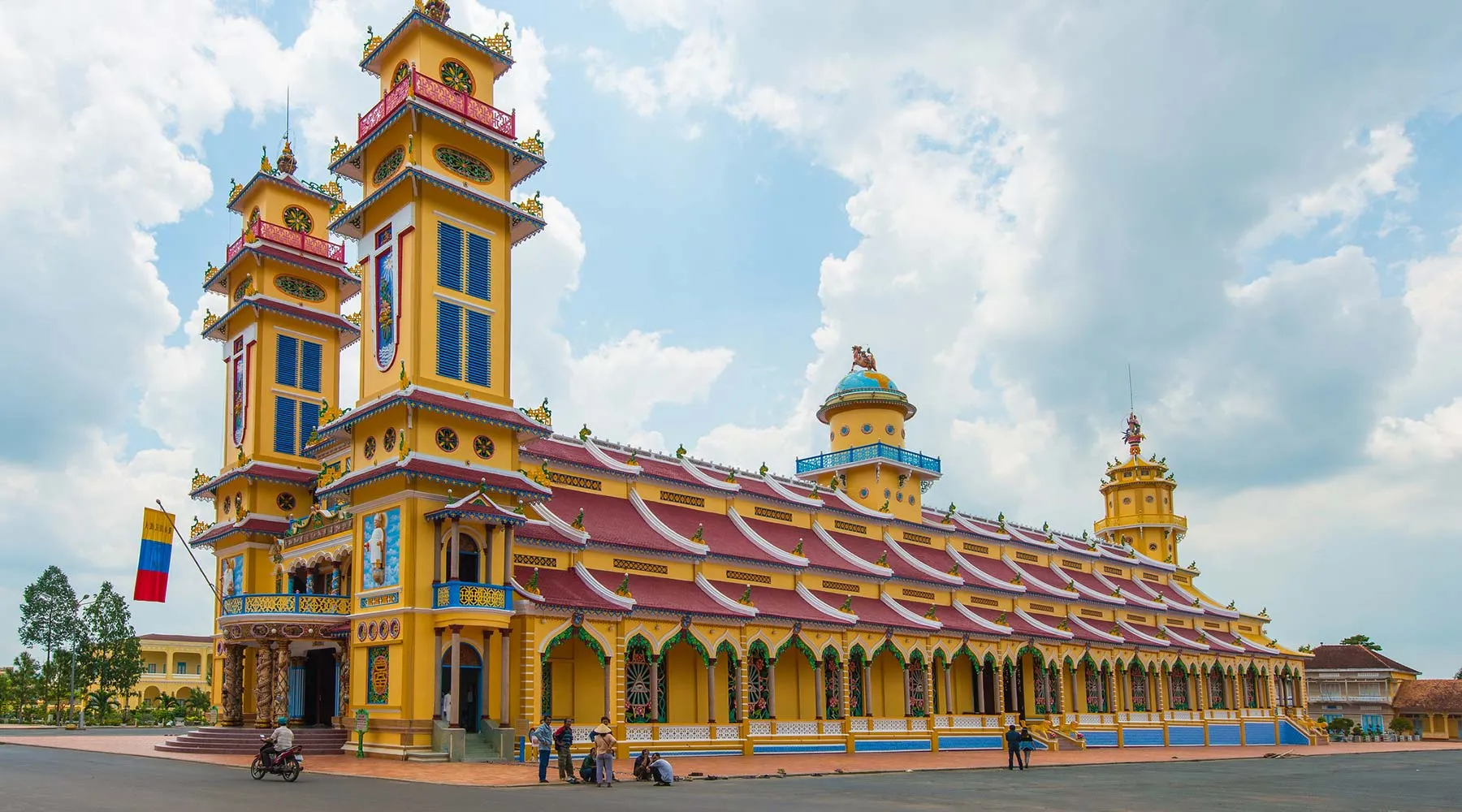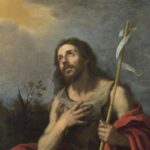
Cao Dai is a unique religious movement that emerged in 1926 in southern Vietnam, blending elements of Vietnamese spiritual traditions, Confucianism, Taoism, Buddhism, and Christianity. With its colorful temples, distinct hierarchy, and emphasis on peace and tolerance, Cao Dai has attracted millions of followers worldwide. This introduction provides an overview of the key aspects of Cao Dai, exploring its beliefs, practices, and cultural significance.
Founded in 1926, Cao Dai emerged in southern Vietnam as a unique blend of Vietnamese spiritual traditions, Confucianism, Taoism, Buddhism, and Christianity. This syncretic religion was established by Ngo Van Chieu, who claimed to receive visions from spiritual entities urging the creation of a new faith uniting various belief systems. Cao Dai’s foundation was influenced by the socio-political landscape of Vietnam during the early 20th century, marked by colonial rule and rapid modernization. It sought to provide a cohesive spiritual framework that resonated with the diverse cultural and religious heritage of the Vietnamese people.
The Holy See of Cao Dai is located in Tây Ninh Province, where the religion’s central temple complex stands as a prominent symbol of its faith. This massive and colorful temple complex features a 130-foot-tall octagonal tower adorned with intricate architectural details and vibrant motifs. At the apex of the tower sits the all-seeing eye symbol, representing the divine presence and omniscience of the Supreme Being in Cao Dai theology. The Holy See serves as a focal point for pilgrimage and religious gatherings, attracting followers and visitors from around the world to witness its grandeur and spiritual significance.
The Divine Trinity forms the cornerstone of Cao Dai belief, comprising three deities: Thượng đế (God the Father), Ngọc Hoàng Thượng đế (God the Son), and Phật Mẫu (the Holy Mother). This trinitarian concept reflects the religion’s syncretic nature, incorporating elements from multiple religious traditions into its theological framework. Followers of Cao Dai worship and venerate these three divine entities, attributing various attributes and roles to each within the cosmic order.
“Tam Kỳ Phổ Độ” (Third World Salvation) serves as the holy book of Cao Dai, outlining its beliefs, practices, and prophesies. This scripture is revered by followers as a sacred text containing divine revelations channeled through mediums who communicate with the spirit world. The writing of “Tam Kỳ Phổ Độ” was guided by spiritual inspiration and collective revelations, with its contents reflecting the syncretic blend of religious influences within Cao Dai philosophy.
The religious hierarchy of Cao Dai is led by three dignitaries: the Pope (Giáo Tông), the Presiding Bishop (Phó Giáo Tông), and the Third Bishop (Tam Giáo Tông). Each of these positions holds specific responsibilities within the spiritual and administrative governance of the faith. The Pope, adorned in a yellow robe, serves as the highest spiritual authority and leader of the Cao Dai community. The Presiding Bishop, dressed in blue, assists the Pope in overseeing religious affairs, while the Third Bishop, wearing red, supports the hierarchy in maintaining doctrinal integrity and spiritual guidance.
Vegetarianism is a prominent dietary practice among many followers of Cao Dai, reflecting the influence of Buddhist principles on the religion’s ethical framework. adherents believe in the sanctity of all life forms and the karmic implications of consuming meat. By abstaining from animal products, they seek to cultivate compassion, minimize harm, and align their actions with the spiritual values of Cao Daism.
Cao Dai temples exhibit a fascinating mix of architectural styles, incorporating elements from Vietnamese, Chinese, Romanesque, and Gothic influences. These eclectic structures serve as sacred spaces for worship, meditation, and communal gatherings within the Cao Dai community. The blending of diverse architectural motifs reflects the syncretic nature of the religion, symbolizing its embrace of cultural diversity and spiritual pluralism.
The “Divine Eye,” also known as the Third Eye, is a prominent symbol in Cao Dai iconography, representing omniscience and spiritual insight. This symbol is often depicted as an eye enclosed within a triangle or radiant halo, symbolizing the divine presence and cosmic awareness of the Supreme Being. Followers of Cao Dai revere the Divine Eye as a source of divine guidance and enlightenment, seeking to awaken their own spiritual vision through meditation and devotion.
Devotees of Cao Dai gather for midday prayer services at noon, participating in rituals that blend elements from different religious traditions. These gatherings provide an opportunity for communal worship, meditation, and spiritual reflection within the Cao Dai community. Through collective prayer and devotion, followers seek to deepen their connection with the divine and uphold the principles of peace, harmony, and universal brotherhood central to Cao Dai teachings.
Cao Dai celebrates various holidays throughout the year, including the Lunar New Year (Tết Nguyên Đán) and the anniversary of founder Ngô Minh Chiêu’s birthday on November 15th. These festive occasions are marked by elaborate rituals, ceremonial offerings, and community gatherings, reflecting the religious and cultural heritage of the Cao Dai tradition. As symbols of spiritual renewal and commemoration, these holidays hold special significance for followers, reaffirming their commitment to the faith and its teachings.
Estimated to have between 2-6 million adherents globally, Cao Dai primarily concentrates in southern Vietnam. This geographical concentration reflects the religion’s historical roots in the region and its strong cultural ties to the Vietnamese people.
Cao Dai features a unique hierarchical structure with separate spiritual and temporal authorities. This organizational framework ensures the effective governance and administration of religious affairs while maintaining doctrinal integrity and spiritual guidance.
The religion has a history of relying on mediums who communicate with the spirit world, channeling messages believed to guide the faith. These spiritual intermediaries play a crucial role in interpreting divine revelations and providing spiritual guidance to the Cao Dai community.
Cao Dai emphasizes peace, tolerance, and respect for all religions, promoting universal brotherhood. These core tenets reflect the religion’s commitment to fostering harmony and understanding among different faith traditions.
Many Cao Dai temples are actively involved in social work and charitable activities, supporting their communities. Through initiatives such as education, healthcare, and poverty alleviation, followers of Cao Dai demonstrate their commitment to compassionate action and social justice.
Cao Dai venerates historical and religious figures like Confucius, Victor Hugo, and Jules Ferry alongside spiritual entities. This eclectic pantheon reflects the religion’s syncretic nature and its reverence for wisdom, compassion, and enlightenment.
The religion assigns symbolic meanings to different animals, with the white horse representing purity and the blue phoenix signifying rebirth. These animal symbols serve as metaphors for spiritual qualities and virtues within the Cao Dai tradition.
Cao Dai upholds a strict moral code emphasizing honesty, compassion, filial piety, and social responsibility. adherents strive to embody these ethical principles in their daily lives, seeking to cultivate virtuous behavior and contribute positively to society.
Meditation practices are encouraged within Cao Dai, promoting self-reflection and spiritual growth. Through meditation, followers seek to quiet the mind, cultivate inner peace, and deepen their connection with the divine.
Religious ceremonies often incorporate chanting, hymns, and instrumental music, creating a unique spiritual atmosphere. These rituals serve as expressions of devotion, reverence, and communion within the Cao Dai community, enriching the religious experience for participants.
Cao Dai’s syncretic nature allows followers to maintain connections to their ancestral traditions while embracing the new religion. This flexibility accommodates diverse cultural backgrounds and spiritual practices within the Cao Dai community, fostering a sense of inclusivity and belonging.
The religion faced periods of persecution during the Vietnam War and under communist rule. Despite these challenges, followers of Cao Dai remained resilient in their faith, preserving its teachings and traditions amidst adversity.
Since the 1990s, Cao Dai has enjoyed greater religious freedom in Vietnam, allowing for the growth and open practice of the faith. This shift in government policy has facilitated the expansion of Cao Dai communities and the revitalization of religious institutions throughout the country.
Cao Dai’s unique blend of philosophies and practices continues to attract interest from scholars and religious studies enthusiasts worldwide. Its syncretic nature, rich symbolism, and emphasis on universal values make it a subject of academic inquiry and cultural fascination.
The global spread of Cao Dai reflects its ability to resonate with individuals seeking spiritual fulfillment and communal belonging. As awareness of the religion grows beyond Vietnam, Cao Dai’s teachings of peace, tolerance, and compassion have the potential to inspire positive change and foster greater understanding among diverse cultures and faith traditions.
FAQs about Cao Dai:
What is the significance of the eye symbol in Cao Dai?
The eye symbol in Cao Dai, known as the “Third Eye” or “Divine Eye,” represents God’s omniscience and all-seeing presence. It emphasizes that humanity’s thoughts and actions are not hidden from the divine. This symbol is depicted prominently in Cao Dai art, architecture (often seen atop temples), and religious iconography.
How does Cao Dai view other religions?
Cao Dai is a monotheistic religion with a strong emphasis on religious tolerance and unity. It follows the principle of “All religions are One,” believing that different faiths represent various paths to the same ultimate truth. Followers respect and acknowledge prophets and founders of other religions, like Jesus Christ, Buddha, and Confucius, seeing them as messengers from the one God. This inclusivity allows Cao Dai adherents to maintain connections to their ancestral traditions while embracing the new faith.
What are the core practices of Cao Dai?
Central to Cao Dai practice is the midday prayer service, held at noon every day. Devotees gather in temples, chanting prayers and performing rituals that combine elements from various traditions. Meditation is also encouraged for self-reflection and spiritual development. Additionally, many followers adhere to a vegetarian diet, reflecting Buddhist influences within Cao Dai. Upholding a strict moral code that emphasizes honesty, compassion, filial piety, and social responsibility is another core aspect of the religion.
What is the structure of the Cao Dai hierarchy?
Cao Dai features a unique hierarchical structure with separate spiritual and temporal authorities. The spiritual realm is led by the Pope (Giáo Tông), assisted by the Presiding Bishop (Phó Giáo Tông) and the Third Bishop (Tam Giáo Tông). These positions are distinguished by the color robes worn during ceremonies – yellow for the Pope, blue for the Presiding Bishop, and red for the Third Bishop. The temporal realm deals with administrative matters and is overseen by a separate set of officials.
What is the history of Cao Dai and its current status?
Founded in 1926 in southern Vietnam, Cao Dai quickly gained popularity due to its unique blend of philosophies and emphasis on peace and tolerance. However, the religion faced persecution during the Vietnam War and under communist rule. Since the 1990s, Cao Dai has enjoyed greater religious freedom in Vietnam, allowing for the growth and open practice of the faith. Today, estimates suggest there are between 2-6 million followers globally, with the majority concentrated in southern Vietnam. The religion continues to attract interest due to its syncretic nature and emphasis on universal brotherhood.









